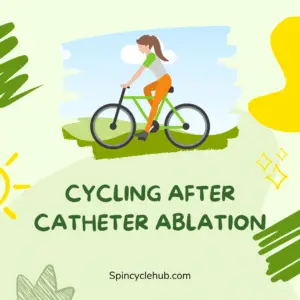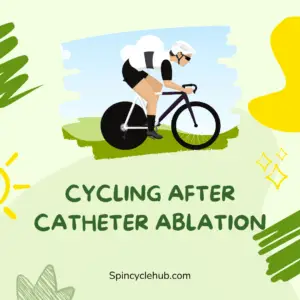Introduction
Cycling is not just a hobby; it’s a way of life for many enthusiasts. The wind in your hair, the freedom of the open road, and the sense of accomplishment when conquering challenging terrains – it’s an experience like no other. But what happens when you’re faced with a heart rhythm disorder that requires a procedure like catheter ablation? The burning question on your mind is, “When can I get back on my bike?” In this article, we’ll delve into the world of cycling after catheter ablation and guide you through the process of returning to your beloved two-wheeler safely.
What is Catheter Ablation?
Before we dive into the cycling aspect, let’s quickly understand what catheter ablation is all about. Catheter ablation is a medical procedure used to treat various heart rhythm disorders, particularly atrial fibrillation. During the procedure, a thin, flexible tube (catheter) is threaded through blood vessels to the heart, where it delivers radiofrequency energy or extreme cold to destroy the abnormal heart tissue causing the rhythm disorder. The goal is to restore a normal heart rhythm and reduce symptoms.

Importance of Recovery
Recovering from any medical procedure is crucial, and catheter ablation is no exception. Patience and caution are essential during this healing process. Your body needs time to heal and adjust after the procedure, ensuring a successful outcome and minimizing the risk of complications. So, as much as you may be itching to get back on your bike, it’s important to prioritize your recovery.
Consulting Your Doctor
When it comes to resuming physical activities, including cycling, after catheter ablation, it’s imperative to consult your doctor. Your healthcare provider knows your medical history, the specifics of your procedure, and can assess your individual readiness for cycling. They will be able to provide personalized advice based on your unique circumstances. So, don’t hesitate to have an open conversation with your doctor about your desire to get back on your bike.
Post-Procedure Guidelines
After catheter ablation, your doctor will provide you with specific guidelines for your recovery. These guidelines may include recommendations on physical activities. While every case is unique, it’s common for doctors to suggest gradually increasing activity levels over time. Initially, you may need to avoid vigorous activities, including cycling, to allow your heart to heal and minimize stress on your body.
Starting Slow and Steady
Once your doctor gives you the green light to resume cycling, it’s important to start slow and steady. Begin with short and easy rides to gauge your body’s response. Listen to how you feel during and after the ride. If you experience any discomfort, chest pain, or abnormal heart rhythms, it’s crucial to stop and consult your doctor immediately. Your body will guide you through the process, and it’s essential to respect its signals.
Monitoring Heart Rate and Rhythm
Monitoring your heart rate and rhythm during cycling is paramount. Invest in a reliable heart rate monitor to keep track of your exertion levels. Your doctor may provide guidance on maintaining a safe heart rate range during exercise. Staying within this range ensures that your heart is not under excessive strain and helps you avoid any potential complications.
Listening to Your Body
During your cycling journey post-catheter ablation, it’s crucial to listen to your body. Pay attention to warning signs such as dizziness, shortness of breath, or irregular heartbeats. These may indicate that you’re pushing yourself too hard or that your heart is not yet ready for the activity. Take breaks when needed and allow yourself to rest. Remember, it’s a gradual process, and your body needs time to adjust.
Building Endurance and Strength
As you progress in your recovery, you can gradually increase the intensity and duration of your cycling sessions. Building endurance and strength is a gradual process, and incorporating cross-training and strength exercises can complement your cycling routine. Consult your doctor or a qualified fitness professional for guidance on exercises that will support your recovery.
Safety Precautions
Safety should always be a priority while cycling, especially after catheter ablation. Make sure to wear appropriate protective gear, including a helmet, to minimize the risk of head injuries. Follow traffic rules, be aware of your surroundings, and practice road safety at all times. Consider cycling with a buddy or joining a group to enhance safety and camaraderie on the road.
Potential Risks and Red Flags
While cycling after catheter ablation is generally safe, there are potential risks and red flags to be aware of. Complications are rare but possible. If you experience severe chest pain, extreme shortness of breath, fainting, or any other concerning symptoms during or after cycling, seek medical attention promptly. Your doctor is best equipped to evaluate and address any issues that may arise.
Gradual Progression and Patience
Recovering from catheter ablation and returning to cycling is a journey that requires gradual progression and patience. Remember that everyone’s recovery timeline is different, and comparing yourself to others may lead to frustration. Embrace the process, celebrate each milestone, and maintain a positive mindset. Your determination and resilience will lead you back to the joy of cycling in due time.
Conclusion
Cycling after catheter ablation is an achievable goal for many enthusiasts. By following the guidance of your doctor, respecting your body’s signals, and gradually building your strength and endurance, you can embark on this journey towards recovery. Remember to prioritize safety, listen to your body, and be patient with yourself. The road may have some bumps along the way, but with perseverance, you’ll soon be back in the saddle, enjoying the exhilaration of cycling once again.

FAQs
- Can I resume cycling immediately after catheter ablation?It’s unlikely that you’ll be able to resume cycling immediately after catheter ablation. Your doctor will provide specific guidelines based on your individual case, but in most cases, a period of recovery and gradual reintroduction to physical activities is necessary. It’s essential to follow your doctor’s advice and gradually increase your activity levels over time.
- How long does it take to recover fully and return to cycling?Recovery timelines vary for each individual. It can take anywhere from a few weeks to a couple of months to fully recover from catheter ablation and return to cycling. Factors such as the specific heart rhythm disorder, the extent of the ablation procedure, and your overall health will influence your recovery time. Always consult with your doctor to determine when it’s safe to resume cycling.
- What warning signs should I watch out for during cycling after the procedure?While cycling after catheter ablation, pay attention to warning signs such as severe chest pain, extreme shortness of breath, fainting, or irregular heartbeats. These could indicate that you’re pushing yourself too hard or experiencing complications. If you experience any concerning symptoms, stop cycling immediately and seek medical attention.
- Are there any specific precautions I should take while cycling after catheter ablation?Yes, there are precautions to keep in mind. Wear appropriate protective gear, including a helmet, to minimize the risk of head injuries. Follow traffic rules, stay alert, and practice road safety. Start with short and easy rides, gradually increasing intensity and duration. Monitor your heart rate and rhythm using a reliable heart rate monitor. It’s important to listen to your body and not push yourself beyond your limits.
- Can I participate in cycling events or races after catheter ablation?Participation in cycling events or races after catheter ablation depends on various factors. It’s essential to consult your doctor, who can evaluate your specific condition and provide guidance. In some cases, participation may be possible once you have fully recovered and regained your strength and endurance. However, it’s crucial to follow your doctor’s advice and ensure that you’re in a suitable condition for such activities.
- American Heart Association (AHA) – Exercise After Ablation: This webpage from the American Heart Association offers insights on exercise guidelines after catheter ablation. It provides valuable information on gradually returning to physical activities, including cycling, and offers tips for a safe and effective recovery.
- Cycling Weekly – Returning to Cycling After Illness or Surgery: This article from Cycling Weekly offers practical advice on returning to cycling after illness or surgery, including catheter ablation. While not specific to catheter ablation, it provides useful tips and considerations for safely resuming cycling and regaining fitness.
Watch this one,
Video Credits – Global Cycling Network
DOWNLOAD THIS ARTICLE :Click Here
You May Also Like
-
Breaking the Silence on Disc Brakes: Unveiling Their True Stopping Power
-
Industry Nine Hub Problems: Unraveling the Challenges of a Beloved Component



